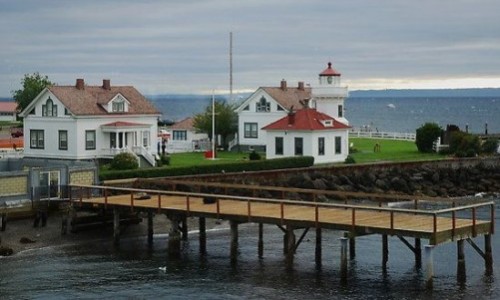By Peter Anderson, Director, Mukilteo Historical Society
Between its early trading post days in the early 1860s and its lumber mill days in the early 1900s, Mukilteo had fledging enterprises focused on brewing beer and salting or canning salmon. These enterprises came and went in concert with the “boom and bust” cycles experienced by early Mukilteo.
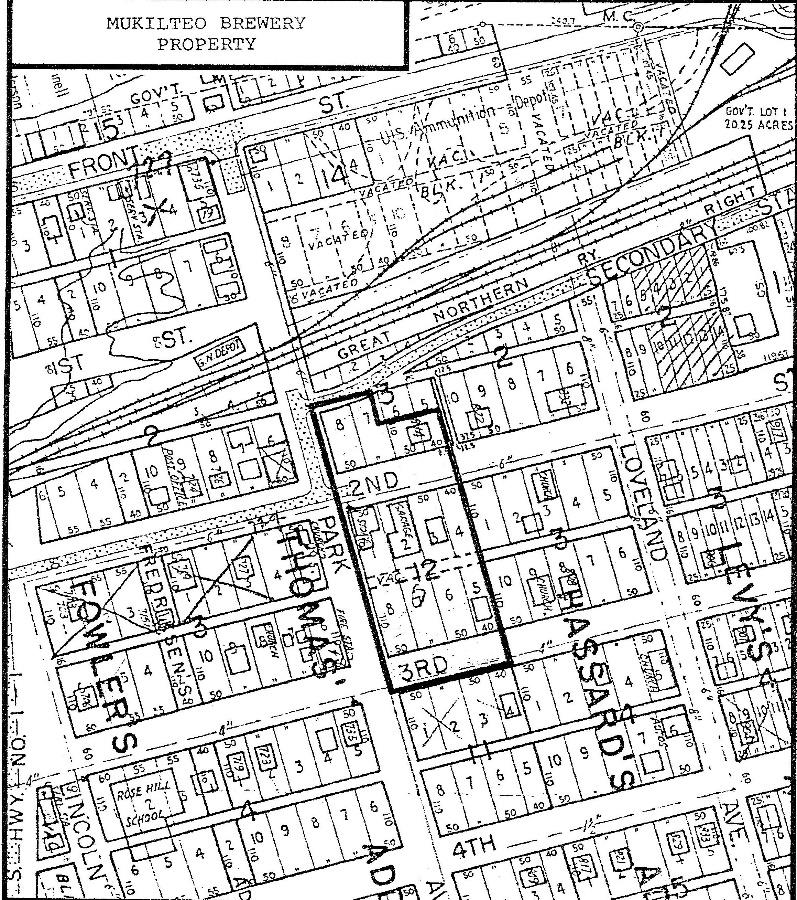
Mukilteo’s beer brewing industry was probably started around 1864 by Mukilteo’s founders, Morris Frost and Jacob Fowler. It was one of their many enterprises that met with varying degrees of success. They built a brewery in a ravine that became known as Brewery Gulch. The ravine was located at the rear of Fowler’s property, and it had a stream that provided ample pure water used for high quality lager beer. The stream was dammed somewhere near the present 3rd Street fill and supplied water power for the malting mill via a 10-horsepower water wheel.
Although Frost and Fowler were listed as proprietors in early Mukilteo Brewery ads, they leased the actual plant operation to a series of experienced brewers. The first of these was probably Joseph Butterfield who was reported to be Frost and Fowler’s brewer in 1867. Before coming to Mukilteo, Butterfield had partnered with Martin Schmieg in establishing breweries in Steilacom and Seattle.
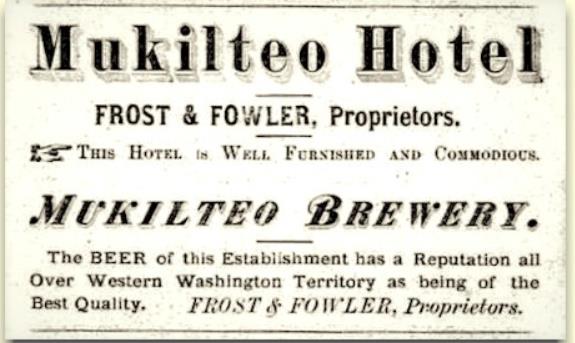
After Butterfield, Jacob Barth leased the brewery from Frost and Fowler. The 1870 Federal Census for Mukilteo, taken in July 1870, lists Jacob Barth as brewer-in-residence. He was born about 1822 in England. Some other names on the same page of the 1870 Federal Census have also been associated with the brewery in Mukilteo. Jacob Rippstein, age 52, was born in Switzerland. He was later listed in the Washington Territorial Census, taken in April 1871, as the brewer in Mukilteo. Charles Thompson, born about 1835 in Sweden, is listed in the 1870 Federal Census on the line just below Jacob Barth’s name. A report dated May 14, 1867, recorded that “Thompson left for across the Sound early, made arrangements to buy out Butterfield in the brewery, made water boxes and put by brewery.”
Butterfield’s name appears again in 1875, when it was reported that the Mukilteo brewery business had been incorporated as the Eagle Brewery with Joseph Butterfield as proprietor. But, by the following year, Mukilteo’s founders Morris Frost and Jacob Fowler took over the enterprise again, purchasing it from Butterfield for $600. Their ownership did not last long. In 1876, Frost & Fowler’s firm had become financially overextended, and they began mortgaging their properties. Their businesses went into receivership in 1877, and foreclosure descended upon them in 1878. As a result of a Sheriff’s sale on February 3, 1878, George Cantieni & Company became the new owners of Mukilteo’s Eagle Brewery.
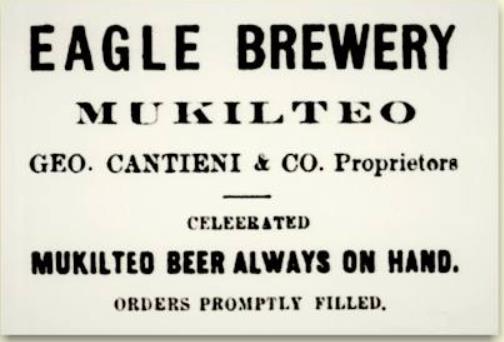
The 1880 Federal Census lists George Cantieni living Mukilteo with occupation “Brewer”. George Cantieni was born about 1838 in Switzerland. Before coming to Mukilteo, he had operated a brewery at Black River, partnering with Martin Schmieg. This previous experience made Cantieni a proficient brewer and manager, and the Eagle Brewery flourished for awhile in a completely refitted plant. But, change in ownership was coming again when Cantieni decided to offer his interest in the plant for sale.
In May 1880, Cantieni placed the following notice in the Seattle Daily Intellegencer:
“FOR SALE – The well-known Eagle Brewery situated at Mukilteo, Snohomish County, W.T. The building is 40×60 feet, three stories high, with hydraulic power. A never-failing stream of soft water suitable for brewing purposes. Well supplied with Tubs, Casks and Kegs, and convenient to daily steamboat navigation. Persons wishing to invest in such property will do well to examine the premises before purchasing elsewhere.”
The notice attracted a Seattle investor named Frederick V. Snyder, who purchased a majority interest in the Eagle Brewery in May 1881. Snyder was a grocer and had operated a slaughterhouse in Seattle. Fire had destroyed his slaughterhouse in 1875. Recognizing he had no experience as a brewer himself, Snyder kept Cantieni on as plant manager. An 1881 advertisement for lager beer made at Mukilteo’s Eagle Brewery shows F. V. Snyder & Co. as proprietors.
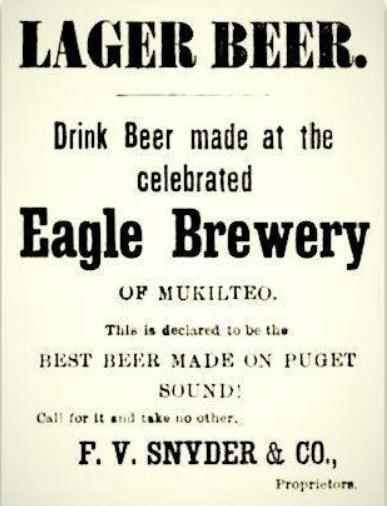
The final chapter of Mukilteo’s Eagle Brewery tale was written on July 21, 1882, when it was completely destroyed by fire. The manager, George Cantieni, was apparently living at the brewery or close by. Newspaper accounts said the fire was discovered around midnight, and Cantieni barely escaped with his life. The fire burned for several hours. The cause was unknown. The plant, belonging to F. V. Snyder, was valued at $2,000. Snyder initially vowed to rebuild the plant in Mukilteo, but later changed his mind. Instead, he decided to build a new Eagle Brewery on his former slaughterhouse property in Seattle. Built under the guidance of George Cantieni, the Seattle Eagle Brewery began operating in December 1882. Bad luck struck again when the Seattle plant also succumbed to fire in the fall of 1883.
At its peak, the Mukilteo Eagle Brewery produced about 500 barrels (15,000 gallons) of lager beer annually. Sailing ships carried its product to Seattle and other Puget Sound outlets. There do not appear to be any visible vestiges remaining of the operation. The ravine that became known as Brewery Gulch is still there, although portions have been filled and paved over for streets. Fifth and Eighth Street cross over the ravine. Visible flow of the stream that once was large enough to bathe in is now just a trickle. The main flow is now mostly hidden, going underground where the former N. J. Smith store (now a seafood restaurant) still stands at 2nd Street and Park Avenue. The flow reaches Puget Sound next to the NOAA research station.
Besides the brewery business, Mukilteo’s early boom and bust cycle also contributed to the comings and goings of enterprises related to the fishing industry. As early as 1863, the Seattle Gazette reported that Frost & Fowler’s dry-goods store in Mukilteo included a store house for packing salmon. They already had twenty tons there – packed and ready for the San Francisco market. They were also building a schooner with a fifty-foot beam to enable them to more extensively and profitably pursue the salmon business. A September 3, 1867, entry in Fowler’s diary indicated $200.00 worth of salted salmon were shipped on that day to various destinations.
In 1870, a salmon-salting business began under the directorship of men named Vining & Rheinbruner. In 1873, V. T. Tull, of Olympia, established his salmon fishery at Mukilteo, mainly for putting up fish in barrels. By 1875, Tull’s operation was taken over by H. C. Vining and his partner, M. Rheinbruner. In February 1876, someone returning from a trip east to Philadelphia reported he had seen forty barrels of salmon for sale there bearing the brand “Reinbruner & Vining, Mukilteo, Washington Territory”. The salmon sold in Philadelphia for $12.50 for a halfbarrel.
In 1877, the salmon salting operation became a salmon cannery built by George Myers & Co., one of the earliest of its kind on Puget Sound. Hearing about the great abundance of fish being caught around Mukilteo, Myers had come from his fishing business on the Columbia River. By July, the cannery was already putting up 1,000 fish per day. Native Americans generally caught the fish, and Chinese workers worked in the cannery. The Native Americans were paid “one to two bits” for salmon weighing eight to ten pounds.
The July 24, 1877, issue of the Daily Pacific Tribune (Seattle, Washington Territory) reported that “2,000 fine salmon were taken in the Jackson & Meyers seines three miles this side of Mukilteo, yesterday morning, the weight of which would average not less than six pounds apiece. These fish were caught for canning and were at once dressed and packed. Nine
Chinamen, to work for this firm in the cannery, came down on the Alida last night, and today went on the Nellie to their place of destination. The Nellie, under charter, went to Tacoma and back last night, taking a scow and bringing down thirty tons of salt and seven hundred barrels, for the Puget Sound Salmon Company, (that is, V. E. Tull & Co.) at the same place, which she also took down to Mukilteo today. The operations of this latter concern are confined to catching, salting and putting barrels and kegs, in which they have engaged about thirty men. Another season they will also can salmon.”
The September 18, 1877, issue of the Daily Pacific Tribune (Seattle, WT) reported that “Jackson & Myers, at Mukilteo, put up 8,000 cans of salmon on Sunday. Yesterday 3,000 fish were caught, and the run is simply immense. The fish taken now are what are known as silversides, beautiful in appearance, and of the finest flavor. They are all taken by hook, and none by seine, and the catchers are all Native Americans. Three Natives went out together yesterday forenoon, in three small canoes, and when they returned to Mukilteo, early in the afternoon, they had 400 splendid fish. Chinese do the work on shore. The canning firm is very well suited with the success of their enterprise at Mukilteo, and word will undoubtedly spread out considerably.”
Pleased with their success, Jackson, Myers and Company leased the fishery and ground for the canning establishment for 10 years, beginning January 1, 1879. They planned to improve the wharf and enlarge the cannery. The winter of 1880 upset their plans. A heavy snowfall caused their cannery roof to collapse. Rather than rebuilding in Mukilteo, they decided to move their operation to Seattle in order to be closer to major transportation facilities. That plant was destroyed by fire in 1888, rebuilt, and burned again in 1891.
Back in Mukilteo, a new cannery and wharf were installed in 1887. Frank L. Tuttle was the head of this installation during the 1888 season. He overhauled the plant, added a patent can filler, built several traps and had a large fleet ready for the run, which was at first disappointing, but which later improved. The 1889 run was unusually large, and the Mukilteo cannery was kept busy. By 1891 it was handling from 4,000 to 5,000 fish daily. The great success may have contributed to the cannery’s undoing.
Perhaps it was concern about overfishing, or concern from Columbia River canneries about losing business to northern neighbors, that prompted the Territorial Legislature to enact a new law prohibiting catching salmon along Puget Sound from March 5 to June 1. The combination of the effects of the new law and the general economic hard times of the 1890s led to the Mukilteo cannery going out of business. With no significant industry, the town became almost extinct until the Mukilteo Lumber Company came in 1903.
We lack information on the exact location of the old cannery. It’s probably safe to assume it was somewhere on our waterfront. One source described the cannery being built “on the point”, so it may have been at or near where our iconic lighthouse stands today. If anyone has more detailed location information or photos of the old cannery, or Eagle Brewery, please contact the Mukilteo Historical Society at info@mukilteohistorical.org.
Originally published in the 2/7/2019 issue of the Mukilteo Beacon.
